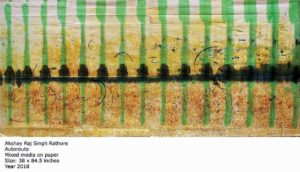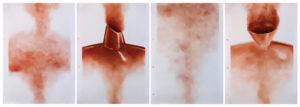Created over the past four years, the artworks of Paris-based artist Akshay Raj Singh Rathore have resonance with the societal turmoil in France as well as in India
Taking a look at Paris-based artist Akshay Raj Singh Rathore’s artworks, one thing is certain – all of them have such diverse connotations, you will be hooked in an attempt to interpret them. His second solo exhibition titled ‘Unpractised Frugality’ adopts the abstract style.
Hailing from Vidisha, Rathore shifted to France from India in around 2014. During that period, he witnessed a lot of societal turmoil both in Europe and back at home in India, which finds a reflection in his work. Created over the last four years, the exhibition showcases a varied yet coherent body of works, unfolding a narrative defining the artist’s thought process and practice.

He was present in Paris when the Charlie Hebdo attack happened, followed by the Bataclan attack, which left a deep impact. “I was there in Paris when the attacks took place, and a large part of the series has a reference to what was happening. Social dystopia, people getting totally disillusioned, racial and migration issues getting highlighted – as an artist I portrayed my feeling through my works,” says Rathore.
Looking back at the situation in India at that time, he recalls the turmoil in the country after a right-wing government came to power.
Defining his ouevre, Rathore aptly says “The vision of the show is political. It will take the viewers towards a new kind of aesthetics which is rooted in the past and surpasses present sense of contemporary contemplation.”
Walking into the gallery one can see several charcoal paintings up on the walls, mostly untitled. A conte on paper (drawing medium) shows a set of black and white exhaust pipes which can be interpreted in different ways. While one can look at it as smoke coming out of gun barrels that are firing in different directions, it can also be looked upon in terms of ecology — the exhaust pipes putting out fumes of black carbon into the atmosphere. Or the toxic fumes of hate crimes.
Similarly, another work of white and brown conte on paper, displays smoke rising in one place and coming out from another funnel. This suggests that crisis does not arises suddenly at one point: the spark is lit somewhere else and the smoke comes out somewhere else.

Giving a context to these works, he says, “The drawings are a reference to the societal fears filtering down to one single individual – which is me as an artist. I am perhaps not suffering, but it is a feeling of vulnerability.”
What stands out the most is the contrast of the works between the two floors of the gallery. The show has two different identities on each floor. “The works downstairs are more vibrant which depict things are growing with reference to me growing and germinating as an artist.”
The transition has been quite accurately captured by a series of works which are on display at the landing of the stairs leading to the underground.
A set of seven works showing small circles that perhaps symbolises the globe — they are slowly cracking. On closer look, one can see a screw inside one of the circles at the end of the series which is cracking it up. “It is a screw, not a nail,” Rathore points out stating that a screw goes in quite slowly as one needs to keep tightening it to fix it.
This work depicts both his global ideas of peace and harmony being disrupted, along with the artist cracking and breaking out of his own shell.
Despite stating that the vision of the works is political, he makes it clear that he is steering away from making any statement with reference to any political ideology. In an attempt to look at the world in a simplified way, his works feature mostly a minimalistic style. “I have tried to revive a certain cultural language, mostly aesthetics, looking back at Indian history where minimalism has been a tradition for a long time.”

Evolved over the years, his style has moved from very defined forms to abstraction, which recreate the past in the present and address the complexity of cross-cultural relations. This is evident in materials, pigments and styles typical of India. “Deep rooted in my Indian thoughts, my work kind of marries the two distinct cultural identities,” explains Rathore.
So why is the exhibition titled ‘Unpracticed Frugality’? Rathore believes Indians are very frugal. “Yet it is not something that can be practised. It comes from within if you are conscious. Hence ‘unpractised’.”
He also wants to spread the message of repurposing — anything that may otherwise be disposed of or is disposable, is brought into play and used to the fullest. In keeping with the theme, the work ‘Autoroute’ has been completed with leftover colours that he transferred on long sheets of paper while working on a different painting. This later on transformed into a work of its own.
“Coming from a farming background, I have managed to criss-cross a large tract of dry land where water is dear and life revolves around this precious commodity. This precious position has created a culture of extreme frugality,” reads the brochure.
The artworks on display force the viewers to think owing to its abstract form. “I have come to a point where I can start seeing the bigger picture. Larger forms which govern us individuals in the society — those forms are abstract. Power is abstract. The economy is abstract. Money and politics is abstract.”
The exhibition is on display at Gallery Espace till April 13





